EXCLUSIVE ARTICLE |
||
|
||
EXCLUSIVE ARTICLE |
||
|
||
|
|||||||
|
|||||||
|
“Here Comes The
Biggest Bond of All…” The James Bond films were kept off UK television until October 1975 (1972 in the USA), and even then only shown sporadically – usually saved for public holidays at Christmas or Easter. In the 2015 Christmas/New Year period no less than six Bond films were shown at least once on UK terrestrial television. It was only in 1982 when the series was released on videotape that fans had access to more James Bond films, but even then not all titles were initially available. |
|||||||
|
|||||||
|
During the 1960s and 1970s the only way to see the James Bond films was in a cinema, so it’s hardly surprising that myths were made and memories have become hazy and confused over the last six decades. Was On Her Majesty’s Secret Service really such a failure? Did I really see From Russia With Love with Thunderball in 1968? Holidaying with grandparents in the summer sometimes gave the opportunity to stumble upon a double-bill and a chance to catch up with old favourites, or to perhaps see the film missed first time around. With no point of reference, private sellers and auction houses to this day still often guess at the date of a double-bill poster on offer; generally assuming that the pairing would be seen the year after the release of the most recent of the two films, but this was rarely the case. The initial release dates of each new Bond film are widely known but what happened in between has rarely, if ever, been documented – until now! Different cities played different films at different times, and cinema managers were then able to book pretty much what they wanted to in order to create their own double-bills. This makes a definitive list of what played where and when almost impossible to compile; however, as the James Bond films all opened first in London's West End (with very few exceptions) it is possible to chart their history in the nation's Capital from 1962 through to 1984, when the last double-bill was released. As the West End is a term used colloquially by Londoners, and not an official geographical or municipal definition, its exact constituent parts are open to debate. However, it is traditionally defined as the two square-miles of streets north of the River Thames where the city's main shopping and entertainment venues are located, and the home of London's ‘Theatreland’. |
|||||||
|
|||||||
|
What follows is a nostalgic look back to a golden age of cinema-going before the concept of actually owning the film yourself could be imagined, let alone a reality. So run down to the usherette standing at the front of the auditorium and buy a carton of Kia-Ora orange juice; then settle down in your seat with a tub of Lyons Maid ice-cream and a small wooden spoon. Look back through the flickering beam in the cigarette smoke and be transported to a time in your childhood when James Bond was back… to back! |
|||||||
|
The London Pavilion was operated by United Artists as their flagship venue to premiere films distributed by the company in the UK until its closure in April 1981. On the evening of Friday October 5, 1962, invited cast and crew members attended a Gala Screening of Dr. No at the London Pavilion. The event was attended by Sean Connery, accompanied by Zena Marshall (Miss Taro in the film), as his girlfriend (and soon to be wife) Diane Cilento had only been granted a divorce a week earlier, and it was deemed too soon for them to be seen in public together. Director Terence Young and Producers Harry Saltzman & Albert R. Broccoli also attended, and Composer Monty Norman was one of the invited guests. James Bond author Ian Fleming brought as his special guest the noted playwright and novelist W. Somerset Maugham (1874-1965). In reality the event was not a ‘Premiere’ in the sense that we know it today. Dr. No had five showings at the London Pavilion on October 5th starting at 10.45am, with invited guests attending the last performance of the day which began at 8.50pm. A party was then held at The Milroy Nightclub, housed within Les Ambassadeurs club in London's Mayfair. The Le Cercle gaming club for members of Les Ambassadeurs was established at the venue in May 1961, and served as the backdrop for James Bond's introduction at the Chemin de fer table opposite Sylvia Trench (Eunice Gayson) in Dr. No (1962). The scene was filmed at Pinewood Studios on March 2, 1962 on a set designed by Ken Adam based on Les Ambassadeurs Club, and where Sean Connery delivers the immortal line “Bond. James Bond.” for the first time. |
|||||||
|
|||||||
|
On Sunday October 7, 1962, Dr. No was released in over 100 cinemas in the UK, and within two weeks had spread to 198 venues where it had already almost recouped its production costs. With the world on the brink of nuclear disaster as the Cuban missile crisis unfolded, the seemingly far-fetched plot of Dr. No became frighteningly real. |
|||||||
|
|||||||
|
Dr. No then played for one week at the 2,370-seat ODEON Kensington from Sunday November 25th, and ended its eight week run at the London Pavilion on Thursday November 29, 1962. Dr. No then transferred to the 800-seat Berkeley Cinema on Tottenham Court Road from Sunday December 2, 1962, where it played until Wednesday January 9, 1963. Dr. No did not have a wide release in the USA until May 1963. Filming on From Russia With Love began on April 1, 1963 – coincidentally the same day that Ian Fleming’s tenth James Bond novel ON HER MAJESTY’S SECRET SERVICE was published in London by Jonathan Cape. The author attended a launch event at his publishers Bedford Square headquarters, and that evening joined the filmmakers and journalists at a special party arranged by EON Productions on ‘D’ Stage at Pinewood Studios to celebrate the double event. |
|||||||
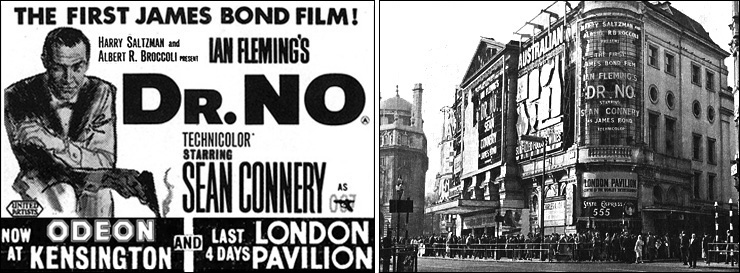 |
|||||||
|
“James Bond is Back!” Ian Fleming also attended the Gala Screening, although his health was particularly fragile. His wife Ann had arranged for Fleming's doctor Jack Beal to also be present. Ian Fleming's health had deteriorated since his heart attack in April 1961, and the strain of the ongoing High Court case with Kevin McClory over the writing of THUNDERBALL was also taking its toll on the author. After the From Russia With Love screening the Fleming's hosted a private party for 70 guests at their London home (16 Victoria Square SW1), away from the media attention. Ian Fleming would visit the set of Goldfinger at Pinewood Studios in March 1964, and later suffered another heart attack at the Royal St. George's Golf Club at Sandwich in Kent on August 11, 1964. Fleming died at Canterbury Hospital on Wednesday August 12, 1964, just five weeks before the release of Goldfinger. |
|||||||
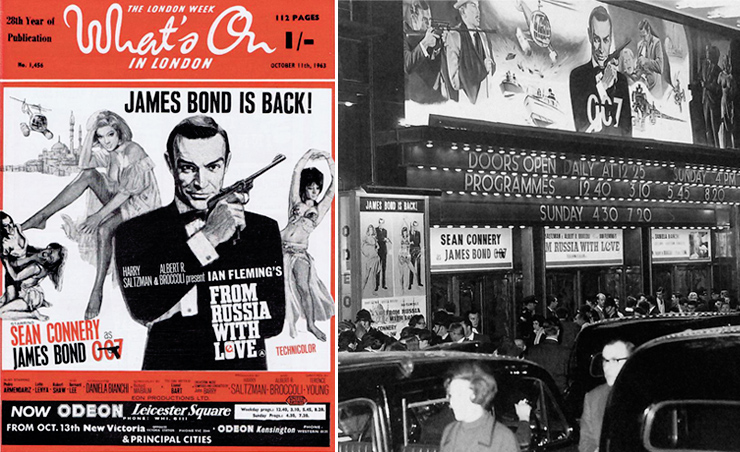 |
|||||||
|
From Russia With Love then opened at the 2,860-seat New Victoria (now the Apollo Victoria), 2,370-seat ODEON Kensington, and principal cities across the country on Sunday October 13, 1963. On the same day it opened in North London cinemas, followed by South London cinemas from Sunday November 3, 1963. It is no surprise that From Russia With Love subsequently became the highest-grossing British film of all time on its initial release, and broke the house record at the ODEON Leicester Square [set by Alfred Hitchcock's The Birds (1963), which had just ended its seven-week run at the ODEON] taking £8,468 in its first four days. From Russia With Love went on to take £14,528 in its first week and also set new records at the ODEON Kensington where it grossed £6,328, and £6,874 at the New Victoria. Due to its enormous popularity From Russia With Love was also shown for three weeks at the huge 2,400-seat ODEON Marble Arch from Thursday October 17, 1963, where it took £5,077 in its first four days, beating the previous best take that was achieved in five days, and going on to take £7,953 in its first week. Although seat prices had increased recently resulting in higher box-office takings, the number of admissions was also taken into account, and it was clear that From Russia With Love was a British box-office phenomenon. The second James Bond film ended its record-breaking six-week engagement at the ODEON Leicester Square on Sunday November 17, 1963, taking an astonishing £3,450 in its last four days. The ODEON Marble Arch had opened in 1928 and operated until March 22, 1964, when it was demolished and replaced by an office block and a new modern single-screen cinema where all of the James Bond films played from 1979 to 1989. Opened in 1967, the new ODEON Marble Arch was the largest cinema constructed in London in the post-war era, with a screen that measured 75 X 30 feet, which for many years was the biggest in the country. Originally constructed to showcase films in the 70mm format, the ODEON Marble Arch later became a first run venue for standard 35mm releases after the decline of ‘Roadshow’ presentations in the early 1970s. The venue was converted into a five-screen complex in September 1996, and reopened in January 1997, with subsequent James Bond films all playing on one of the smaller screens as part of their initial West End run. The ODEON Marble Arch closed in May 2016, and was demolished six months later. |
|||||||
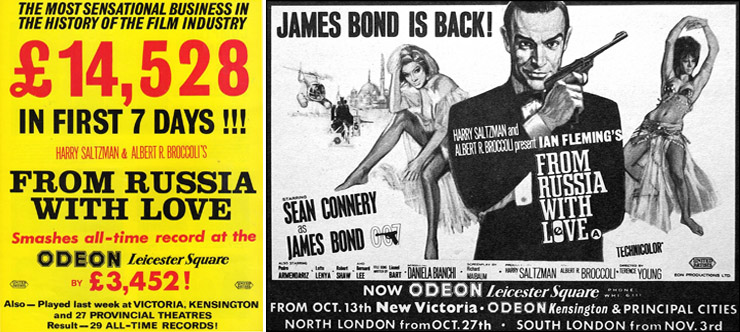 |
|||||||
|
The second James Bond film continued its record-breaking success across London and the rest of the country from Sunday October 27, 1963, in a total of 489 cinemas. From Russia With Love broke records in 27 key provincial cinemas including the ODEON Birmingham where it took £7,976 in its first week; £6,736 at the ODEON Glasgow in five days; £5,912 at the Gaumont in Sheffield, and over just £3,000 at the ODEON Northampton! It is estimated that more than 250,000 people saw From Russia With Love in its first week alone, when the average ticket price was three shillings. [In pre-decimal days there were 20 shillings in one pound - 3 shillings is the equivalent of 15 pence in decimal currency]. In order to capitalise on the enormous public demand to see the film, the original 85-minute supporting feature Stowaway In The Sky (1960) was replaced by a 24-minute documentary/travelogue This is Jordan (1963), which enabled cinemas to schedule more screenings each day. The trade publication Kinematograph Weekly reported that police were called at many locations to control the enthusiastic crowds queuing to see From Russia With Love. |
|||||||
|
|||||||
|
Following its initial six-week engagement at the ODEON Leicester Square, From Russia With Love returned to the West End on Thursday November 21, 1963, at the 430-seat Ritz cinema in Leicester Square where it played for another four weeks. Still very popular with audiences, From Russia With Love took £1,300 in its first four days at the Ritz, and played to capacity houses on a weekend. On Friday December 20, 1963, Dr. No was revived at the 420-seat Gala Royal, Marble Arch, playing for eight weeks until Thursday February 13, 1964. From Russia With Love opened the same day at the 640-seat Continentale cinema (known as La Continentale) on Tottenham Court Road, where it played for six weeks until Wednesday January 29, 1964. To capitalise on the success upon its initial release, From Russia With Love was quickly re-issued ‘By public demand!’ in selected North London cinemas for one week from January 19, 1964; and in South London the following Sunday. |
|||||||
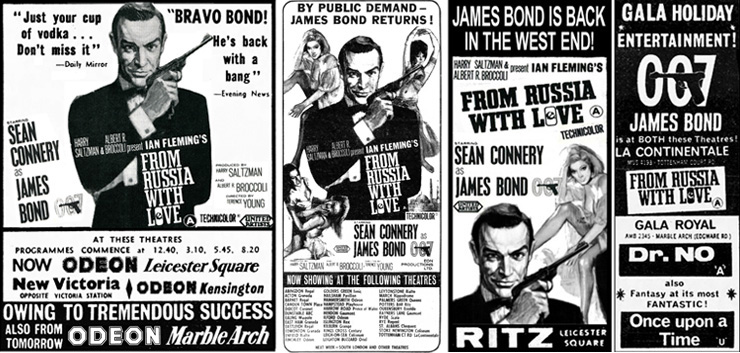 |
|||||||
|
The ODEON Hammersmith [pictured below right] screened From Russia With Love for six days from Monday January 20, 1964. Opened in 1932 as the Gaumont Palace, the 3,487 seat cinema was renamed the ODEON Hammersmith in 1962, and became known as one of London’s major live entertainment venues, playing host to some of the world's greatest performers. On Sunday January 19, 1964 the ODEON Hammersmith hosted two concerts by The Tommy Dorsey Orchestra supported by Frank Sinatra Jr., who returned the following Sunday for a repeat engagement after From Russia With Love had ended its six-day run. The venue became a Grade II listed building in 1990, and was renamed the Hammersmith Apollo [now eventimapollo], with occasional film screenings to fill empty dates between its live shows and concerts. |
|||||||
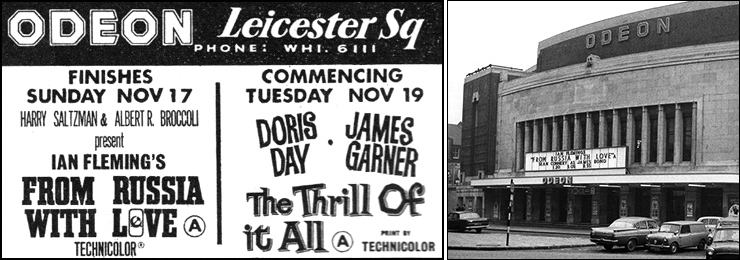 |
|||||||
|
||||
|
“James Bond Back
in Action!” |
||||
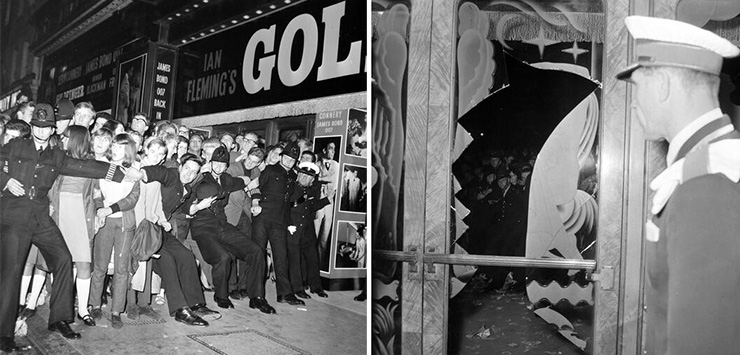 |
||||
|
Honor Blackman attended wearing a specially commissioned 22-carat ‘gold finger’ jewel [designed by Mexican-born British jeweller Charles de Temple (1929-2019)], along with co-stars Gert Frobe, Nadja Regin, Tania Mallet, Shirley Eaton and title song performer Shirley Bassey. Also attending was Michael Caine who would later star as Harry Palmer in three films produced by Harry Saltzman from the novels of Len Deighton. Sean Connery did not attend due to filming commitments in Spain for Sidney Lumet's The Hill (1965). This was the first true James Bond Premiere as Goldfinger only played once at the ODEON Leicester Square on September 17, 1964, before opening to the public the following day. |
||||
|
||||
|
Goldfinger then opened at nine large ‘Premiere Showcase Theatres’ in the London suburbs from Sunday September 20, 1964; and key cities across the country from Sunday October 4, 1964. This new release pattern was modelled on New York's ‘Red Carpet Theatres’ which gave more London cinemagoers the opportunity to see the film just three days after its West End Premiere, although ticket prices were slightly higher than those charged for general releases. Goldfinger marked the first time that ‘Premiere Showcase Theatres’ showed new films well ahead of their general release in Britain. |
||||
|
||||
|
Co-Producer Albert R. Broccoli and his wife Dana attended a screening at the 2,128-seat ODEON Streatham on Thursday September 24, 1964, which attracted a crowd of 1,200 fans. It was later reported in the Streatham News that more than 70,000 people had seen Goldfinger in its first three weeks at the ODEON. To cater for those cinemagoers who were unable to get in, a special midnight screening was arranged for Saturday October 10, 1964 - the final performance of its three-week season. At this time it was unusual for suburban cinemas to have late-night screenings, and these could only take place with approval from the local Council licensing authority. A late-night screening of Goldfinger at the 1,254-seat ODEON Northfields, Ealing on Saturday October 24, 1964, was the first such event for seven years. On Tuesday September 15, 1964, two days before the Premiere of Goldfinger, both Harry Saltzman & Albert R. Broccoli (accompanied by their wives) had attended Ian Fleming's memorial service in London held at the church of St. Bartholomew the Great, Smithfield. Also attending were Michael Howard representing publisher Jonathan Cape; and illustrator Richard Chopping, who painted the trompe l'oeil dust jacket illustrations for nine of Ian Fleming's James Bond novels beginning with FROM RUSSIA, WITH LOVE in 1957. |
||||
|
Thunderball had been announced as the next film in the series on September 23, 1964, but prints of Goldfinger currently showing in London and across the country still bore the end caption ‘But James Bond will be back “On Her Majesty's Secret Service.”’ Producers Albert R. Broccoli & Harry Saltzman had recently come to an agreement with Kevin McClory following his acquisition of the screen rights to THUNDERBALL in 1963. Rather than have McClory release a rival Bond film as he had announced, Broccoli & Saltzman reluctantly went into partnership with the Irishman. A new end credit was hastily created for Goldfinger and subsequent UK prints (and all US prints of the film) correctly named Thunderball as the next film in the series. |
||||
|
||||
|
Goldfinger once again broke the house record at the ODEON Leicester Square, taking £9,938 in the first four days after the World Premiere, and £17,327 by the end of its first week. The third James Bond film went on to take £32,874 in its first fortnight, shattering all records held by its predecessor From Russia With Love, and becoming the highest grossing film ever released in the UK. Records were also smashed at the nine ‘Premiere Showcase Theatres’ where Goldfinger screened ahead of its general release across the UK on Sunday October 18, 1964. Distributor United Artists were keen to promote the spectacular box-office receipts in American trade journals ahead of the US release at the end of the year. |
||||
|
||||
|
“James Bond 007
Takes Over Leicester Square!” |
||||
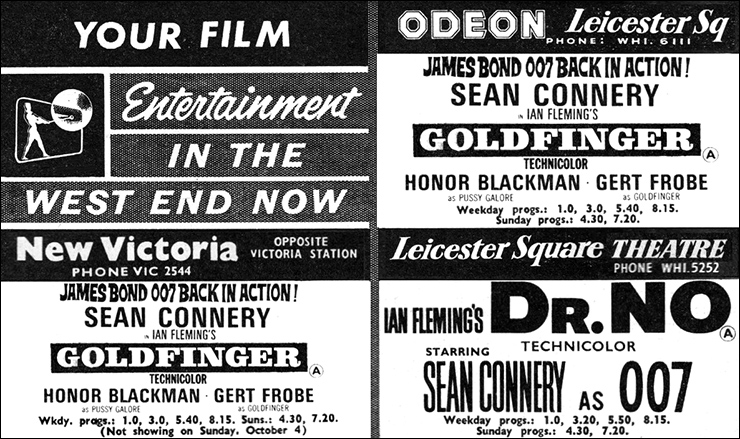 |
||||
|
After grossing £80,120 in its six weeks at the ODEON Leicester Square Goldfinger then replaced Dr. No at the Leicester Square Theatre on Thursday October 29, 1964, where it played for a further seven weeks until Wednesday December 16, 1964. When the revival of Dr. No went on general release across the UK from Sunday November 1, 1964, it was supported in many locations by the 1959 Hammer Film The Hound Of The Baskervilles, also distributed by United Artists. It was originally announced that From Russia With Love would replace Dr. No at the Leicester Square Theatre from Thursday October 15, 1964, but the first James Bond film proved so popular screening opposite Goldfinger at the ODEON that it was retained throughout October. |
||||
|
||||
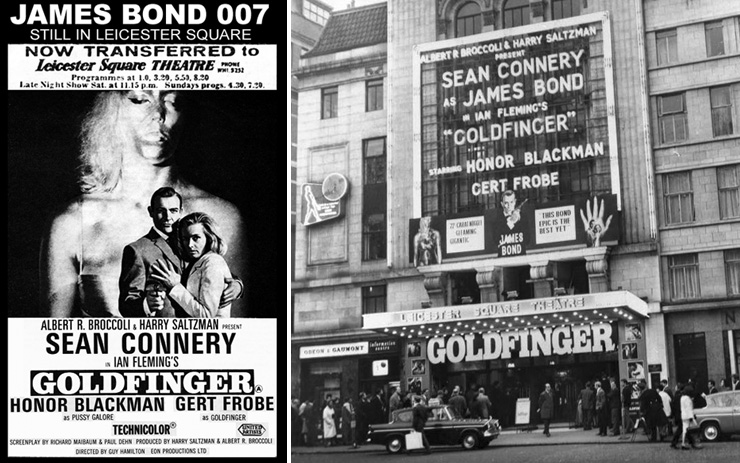 |
||||
|
Dr. No was then revived for another seven days from Sunday November 29, 1964, at the ODEON Kensington where it took £3,750. James Bond once again became ‘Gala Holiday Entertainment For Everyone!’ when on Saturday December 26, 1964, Goldfinger opened at the Gala Royal Cinema, Marble Arch; whilst Dr. No played for the same five weeks at La Continentale. Goldfinger also played concurrently at the Berkeley on Tottenham Court Road – primarily an 800-seat independent art-house cinema owned by Kenneth Rive (along with La Continentale; Gala Royal, Marble Arch and International Film Theatre, Bayswater). The founder of Gala Film Distributors in 1952, Kenneth Rive (1918-2002) was the biggest distributor of foreign films in the UK, and largely responsible for introducing British audiences to the works of Francois Truffaut and Ingmar Bergman. His London cinemas showcased Continental art-house films, but also became second run venues for more popular mainstream films such as the James Bond series, which were more or less guaranteed money-makers for Rive and his company. |
||||
|
||||
|
|
||||